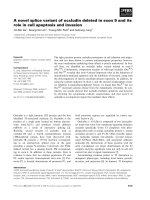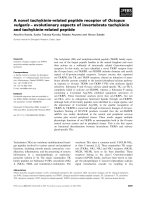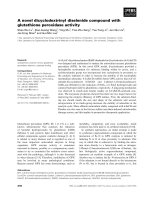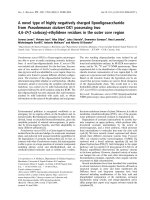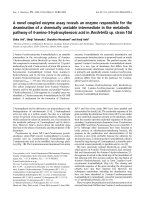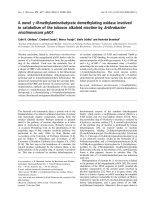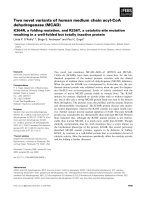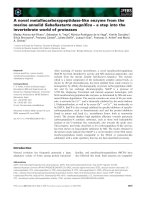Báo cáo khoa học: A novel inhibitor of indole-3-glycerol phosphate synthase with activity against multidrug-resistant Mycobacterium tuberculosis pptx
Bạn đang xem bản rút gọn của tài liệu. Xem và tải ngay bản đầy đủ của tài liệu tại đây (572.89 KB, 11 trang )
A novel inhibitor of indole-3-glycerol phosphate synthase
with activity against multidrug-resistant
Mycobacterium tuberculosis
Hongbo Shen
1,
*, Feifei Wang
1,
*, Ying Zhang
2
, Qiang Huang
1
, Shengfeng Xu
1
, Hairong Hu
1
,
Jun Yue
3
and Honghai Wang
1
1 State Key Laboratory of Genetic Engineering, School of Life Sciences, Fudan University, Shanghai, China
2 Department of Molecular Microbiology and Immunology, Bloomberg School of Public Health, Johns Hopkins University,
Baltimore, MD, USA
3 Department of Clinical Laboratory, Shanghai Pulmonary Hospital, China
Tuberculosis (TB) is the leading cause of infectious
morbidity and mortality worldwide, with nine million
new cases and two million deaths per year (http://
www.tballiance.org). Approximately two billion people
are latently infected with Mycobacterium tuberculosis,
comprising a critical reservoir for disease reactivation
Keywords
drug resistance; indole-3-glycerol phosphate
synthase; inhibitor; Mycobacterium
tuberculosis
Correspondence
H. Wang, State Key Laboratory of Genetic
Engineering, School of Life Sciences, Fudan
University, Shanghai 200433, China
Fax: +86 21 65648376
Tel: +86 21 65643777
E-mail:
J. Yue, Department of Clinical Laboratory,
Shanghai Pulmonary Hospital, Shanghai
200433, China
Fax: +86 21 65648376
Tel: +86 21 65643777
E-mail:
*These authors contributed equally to this
work
(Received 19 June 2008, revised 19 October
2008, accepted 28 October 2008)
doi:10.1111/j.1742-4658.2008.06763.x
Tuberculosis (TB) continues to be a major cause of morbidity and mortal-
ity worldwide. The increasing emergence and spread of drug-resistant TB
poses a significant threat to disease control and calls for the urgent devel-
opment of new drugs. The tryptophan biosynthetic pathway plays an
important role in the survival of Mycobacterium tuberculosis. Thus, indole-
3-glycerol phosphate synthase (IGPS), as an essential enzyme in this path-
way, might be a potential target for anti-TB drug design. In this study, we
deduced the structure of IGPS of M. tuberculosis H37Rv by using homol-
ogy modeling. On the basis of this deduced IGPS structure, screening was
performed in a search for novel inhibitors, using the Maybridge database
containing the structures of 60 000 compounds. ATB107 was identified as
a potential binding molecule; it was tested, and shown to have antimyco-
bacterial activity in vitro not only against the laboratory strain M. tubercu-
losis H37Rv, but also against clinical isolates of multidrug-resistant TB
strains. Most MDR-TB strains tested were susceptible to 1 lg ÆmL
)1
ATB107. ATB107 had little toxicity against THP-1 macrophage cells,
which are human monocytic leukemia cells. ATB107, which bound tightly
to IGPS in vitro, was found to be a potent competitive inhibitor of the sub-
strate 1-(o-carboxyphenylamino)-1-deoxyribulose-5¢-phosphate, as shown
by an increased K
m
value in the presence of ATB107. The results of site-
directed mutagenesis studies indicate that ATB107 might inhibit IGPS
activity by reducing the binding affinity for substrate of residues Glu168
and Asn189. These results suggest that ATB107 is a novel potent inhibitor
of IGPS, and that IGPS might be a potential target for the development
of new anti-TB drugs. Further evaluation of ATB107 in animal studies is
warranted.
Abbreviations
CdRP, 1-(o-carboxyphenylamino)-1-deoxyribulose-5¢-phosphate; CFU, colony-forming unit; DOPE, discrete optimized potential energy; IGPS,
indole-3-glycerol phosphate synthase; MDR-TB, multidrug-resistant tuberculosis; MIC, minimum inhibitory concentration; mIGPS, indole-3-
glycerol phosphate synthase of Mycobacterium tuberculosis ; MTT, 3-[4,5-dimethylthiazol-2-yl]-2,5-diphenyl-tetrazolium bromide; SPR, surface
plasmon resonance; TB, tuberculosis.
144 FEBS Journal 276 (2009) 144–154 ª 2008 The Authors Journal compilation ª 2008 FEBS
[1]. The alarming increase in drug-resistant TB, espe-
cially multidrug-resistant TB (MDR-TB, resistant to at
least isoniazid and rifampin), poses a significant threat
to effective TB control [2]. Therefore, there is an
urgent need to develop novel drugs for the treatment
of TB, especially MDR-TB ( />It was reported that auxotrophs of M. tuberculosis
that are knocked out in the leucine, proline and tryp-
tophan biosynthetic pathways show attenuation in
their ability to infect mice [3,4]. This indicates that
these amino acids might be unavailable for uptake by
the bacterium in vivo [5]. The attenuation of virulence
is especially marked in the tryptophan auxotrophic
trpD knockout strain, which is essentially avirulent,
even in immunodeficient mice [4]. This suggests that
the tryptophan biosynthetic pathway might play
an important role in the survival of M. tuberculosis
in vitro and in vivo. Additionally, tryptophan is not
synthesized by mammals, making enzymes from this
biosynthetic pathway viable targets for new anti-TB
drugs [5]. Indole-3-glycerol phosphate synthase (IGPS)
catalyzes the fourth step in this biosynthetic pathway,
the indole ring-closure reaction, in which the substrate
1-(o-carboxyphenylamino)-1-deoxyribulose-5¢-phospha-
te (CdRP) is converted to the product indole 3-glycerol
phosphate (IGP) [6]. The trpC gene, encoding IGPS,
was demonstrated to be essential for the growth of
M. tuberculosis in vitro by inactivation by transposon
mutagenesis [7]. In addition, there is no homolog of
IGPS in humans [8]. Thus, IGPS of M. tuberculosis
(mIGPS) could be a good drug target for the design of
new anti-TB agents.
Virtual high-throughput in silico screening is an
important tool in drug discovery [9]. It aims to
identify chemical ligands that bind strongly to key
regions of important enzymes. Consequently, identi-
fied ligands may provide excellent inhibition of
enzyme activities. Several drugs discovered using this
approach have been tested clinically [10–12]. In this
study, we have identified a high-affinity inhibitor,
ATB107, of mIGPS, using the virtual screening
approach. The inhibitor was found to be a competi-
tive inhibitor of mIGPS, as it reduced the binding
affinity for substrate to residues required for enzyme
activity and effectively inhibited the growth of not
only the virulent M. tuberculosis H37Rv labora-
tory strain but also of drug-resistant clinical isolates
in vitro. The inhibitory effect of ATB107 could not be
reversed by the addition of tryptophan, as it might
affect not only the biosynthesis of tryptophan but also
other essential pathways.
Results and Discussion
Homology modeling of mIGPS structure
IGPS is a key enzyme in the tryptophan biosynthetic
pathway, which is widely present in bacteria [13].
There has been significant interest in its structure [14].
More than 20 crystal structures of bacterial IGPS have
been determined () [15]. Six possi-
ble templates (Protein Data Bank codes: 1A53, 1H5Y,
1I4N, 1JCM, 1PII and 1VC4) for homology modeling
were identified through a homology search. The struc-
ture of 1VC4 was selected as the template, because of
the highest sequence identity of 45.6%. Furthermore,
sequence alignment analysis (Fig. 1) revealed a higher
sequence similarity of 55.43% between the 1VC4 and
mIGPS sequences. Using homology modeling, five
models, M1, M2, M3, M4 and M5, for mIGPS were
obtained, and their modeller objective function [16]
values were 1633.37, 1745.01, 1681.45, 1650.79 and
1611.09, respectively. The last value is the lowest one,
which means that M5 is the ‘best’ model. Furthermore,
the discrete optimized potential energy (DOPE) score
[17] profile of M5 (Fig. 2A) is very similar to that of
the template (Fig. 2B), which also indicates that M5 is
a reasonable model. Figure 2C shows that the mIGPS
structure (M5) has one typical (b ⁄ a)
8
-barrel structure,
which is the most common enzyme fold in nature [18].
Fig. 1. Amino acid sequence alignment of
IGPS from M. tuberculosis H37Rv and that
from Thermus thermophilus reveals high
sequence similarity (55.43%). The second-
ary structures of T. thermophilus IGPS are
shown under the sequences. The a-helices
are shown as red helices, and the b-sheets
as blue arrows. The sequence alignment
was performed using
BIOEDIT software [39].
H. Shen et al. Inhibitor of indole-3-glycerol phosphate synthase
FEBS Journal 276 (2009) 144–154 ª 2008 The Authors Journal compilation ª 2008 FEBS 145
Virtual selection of mIGPS inhibitors
To obtain a more reasonable structure, we performed
nanosecond timescale molecular dynamics simulations
for the structure of M5. The plots of potential energy
fluctuation (Fig. 3A) and protein backbone rmsd
(Fig. 3B) from simulations show that the structure was
equilibrated after 1 ns of simulation. Thus, we selected
the last 9 ns simulation results to obtain an average
structure using the g_rmsf program of gromacs.
The equilibrated structure of mIGPS was used in the
virtual selection of inhibitors, using the autodock
approach. The docking dummy center was arranged in
the middle of the barrel composed of C-termini of
b-sheets. The radius of the docking region was 22.5 A
˚
,
and it was beyond the width of the cavity in mIGPS,
which was about 15–18 A
˚
. This ensured that the
ligands could reach the mIGPS catalytic cavity during
the docking process. Figure 4A shows that the ligands
with low docking energy values mostly bound in the
region surrounded by the ba-loops. One hundred
ligands with the lowest docking energy values were
selected from the 60 000 ligands, and 50 of them were
purchased and used in further evaluation of their
antimycobacterial activities.
Antimycobacterial activities of the selected
ligands in vitro
We first evaluated the antibacterial activity of 50
ligands against M. tuberculosis H37Ra, which is a
A
B
C
Fig. 2. Structure of IGPS. The DOPE score profile of M5 (A) is
highly similar to that of the template (B), which confirms that M5 is
a reasonable model. The structure (C) of IGPS from M. tuberculosis
H37Rv (M5) has one typical (b ⁄ a)
8
-barrel structure.
Fig. 3. Plots of the potential energy fluctuation (A) and protein
backbone rmsd (B) in mIGPS molecular dynamics simulations. The
results showed that the structure was equilibrated after 1 ns of
simulation. Thus, the last 9 ns simulation results were selected to
obtain an average structure of mIGPS using the
G_RMSF program of
GROMACS.
Inhibitor of indole-3-glycerol phosphate synthase H. Shen et al.
146 FEBS Journal 276 (2009) 144–154 ª 2008 The Authors Journal compilation ª 2008 FEBS
highly attenuated M. tuberculosis strain [19]. The mini-
mum inhibitory concentration (MIC) of ATB107
(Fig. 4B) is 0.1 lgÆmL
)1
for M. tuberculosis H37Ra
and also vaccine strain BCG (Table 1). ATB107 is a
nitrogen heterocyclic ligand fused with polycyclic rings.
Its molecular formula is C
21
H
28
N
8
, its chemical name
is 1-azabicyclo[2.2.2]octan-3-one[4-(phenylamino)-6-(1-
piperidinyl)-1,3,5-triazin-2-yl]hydrazone, and its molec-
ular mass is 392.5 Da. There are four hydrogen bond
donors, eight acceptors, and six rotatable bonds, and
its xlogP (partition coefficient in octanol ⁄ water) is 4.46
(). This suggests that the
ligand obeys Lipinski’s ‘rule of five’ [20].
ATB107 also had high activity against M. tuberculosis
H37Rv, with an MIC of 0.1 lgÆmL
)1
(Table 1). Using
the BACTEC culture system, we observed inhibition of
bacterial growth when clinical isolates of M. tuberculo-
sis were exposed to two concentrations of ATB107. All
50 fully susceptible clinical isolates tested were suscep-
tible to ATB107 at 1 lgÆmL
)1
; of these, 41(82%) were
susceptible to ATB107 at 0.1 lgÆmL
)1
(Table 2). Using
the same approach, we evaluated the activity of
ATB107 against 80 clinical MDR-TB isolates. The
results showed that 67 (83.8%) MDR-TB isolates were
susceptible to ATB107 at 1 lgÆmL
)1
, and 25 (31.3%)
isolates were susceptible to ATB107 at 0.1 lgÆmL
)1
(Table 2).
Interaction of ATB107 with mIGPS
We performed a surface plasmon resonance (SPR)
analysis to identify the interaction of ATB107 with
mIGPS. Kinetic analysis of the binding interaction
between ATB107 and mIGPS (Fig. 5) showed that the
binding ability of ATB107 was well correlated with its
concentrations. The equilibrium dissociation contant
Fig. 4. Ligands with low docking energy values binding to the
region surrounded by the ba-loops of mIGPS (A). The deep yellow
ball is the dummy center of the docking region. The colored mole-
cules are the ligands. The most effective ligand, ATB107 (B), is a
nitrogen heterocyclic ligand fused with polycyclic rings.
Table 1. MICs of ATB107 for different M. tuberculosis strains.
Bacteria (10
5
CFUÆmL
)1
) were inoculated in Middlebrook 7H9 broth
with OADC. ATB107 was added to obtain concentrations ranging
from 0.01 to 200 lgÆmL
)1
. After 3 weeks of incubation, the cul-
tures were diluted and plated on agar plates for CFU determination.
The MIC was defined as the lowest concentration that inhibited
99% of growth. The tests were repeated three times for each
strain.
Mycobacterial species No. strains MIC (lgÆmL
)1
)
M. tuberculosis H37Ra 1 0.10
M. tuberculosis H37Rv 1 0.10
M. bovis BCG 1 0.10
Table 2. Susceptibility of M. tuberculosis clinical isolates to
ATB107 measured by the BACTEC radiometric system. The tests
were repeated twice for each strain.
M. tuberculosis
strains
Total
number
of strains
No. (%)
strains
inhibited by
1.0 lgÆmL
)1
No. (%)
strains
inhibited by
0.1 lgÆmL
)1
M. tuberculosis,
fully susceptible clinical
isolates
50 50 (100) 41 (82)
MDR-TB strains
(resistant to at least
isoniazid and rifampin)
80 67 (83.8) 25 (31.3)
H. Shen et al. Inhibitor of indole-3-glycerol phosphate synthase
FEBS Journal 276 (2009) 144–154 ª 2008 The Authors Journal compilation ª 2008 FEBS 147
(k
D
) was 3 · 10
)3
m. These results indicate that
ATB107 can bind tightly to mIGPS in vitro.
To elucidate the effect of ATB107 binding on
enzyme activity, we tested the catalytic activity of
mIGPS in the presence of this ligand. A plot of the
ligand concentrations against mIGPS activity (Fig. 6A)
showed that the activity decreased significantly with
increase in ligand concentration. The 50% inhibitory
concentration was about 0.41 lm. The results indicate
that binding of ATB107 reduces the catalytic activity
of mIGPS, and that ATB107 is a high-affinity inhi-
bitor of mIGPS.
Mechanism of inhibition by ATB107
To identify whether ATB107 is a competitive or non-
competitive inhibitor, we tested the effect of inhibitor
on the Michaelis constant K
m
of the substrate CdRP.
Inhibitors were added to the reaction solutions to
achieve concentrations of 0.2 and 2 lm, respectively. A
plot of reciprocal velocity versus reciprocal substrate
concentration (Fig. 6B) showed that the inhibitor
increased the K
m
, and that the K
m
increase was corre-
lated with higher concentrations of inhibitors. It is
concluded that ATB107 might be a competitive inhibi-
tor of mIGPS.
In order to ascertain the mechanism by which
ATB107 inhibits the catalytic activity of mIGPS, we
mutated the residues close to the ATB107-binding sites
in mIGPS (Fig. 7A) and tested the enzyme activities of
these mutants. There are 11 residues surrounding
ATB107 within a distance of 5 A
˚
. Ten of them were
mutated to alanine, with a methyl group side chain,
except for Ala190. The enzyme activities of mutants
were assayed under the same conditions. The results
(Table 3) demonstrate that mutations of Glu168 and
Asn189 greatly affected the activities of the enzymes
and increased the K
m
values 19-fold and 18-fold,
respectively. These results suggest that the above resi-
dues might play an important role in the catalytic pro-
cess of mIGPS and may be related to the inhibition
mechanism of ATB107.
To investigate the role of these residues in the inhib-
itory effect of ATB107, we compared the binding sites
of CdRP and of ATB107. The substrate-binding sites
were also calculated using autodock software. The
results showed that eight of the 11 residues surround-
ing ATB107 (yellow) within 5 A
˚
in mIGPS (Fig. 7A)
are the same as eight of the 14 residues surrounding
the substrate (red) within 5 A
˚
(Fig. 7B). This suggests
that CdRP might bind to a similar region as the inhib-
itor. Structure superposition results (Fig. 7C) con-
firmed this conclusion. Therefore, these results suggest
that the inhibitor competes with substrate in binding
150
100
50
Resp. diff. (RU)
0
–50
–100
50 60 70 80 90 100 110 120 130
a
b
c
d
e
f
140 150 160
Time (s)
Fig. 5. Kinetic analysis of ATB107 binding to mIGPS by SPR tech-
nology using BIAcore 3000. The results show that the binding abil-
ity of ATB107 is well correlated with its concentrations, which
means that ATB107 binds well to mIGPS in vitro. Representative
sensorgrams obtained from injection of ATB107 at concentrations
of: (A) 0.50 · 10
)5
M; (B) 0.25 · 10
)5
M; (C) 0.13 · 10
)5
M; (D)
0.31 · 10
)6
M; (E) 0.78 · 10
)7
M; (F) 0.39 · 10
)7
M.
Fig. 6. Effect of ATB107 binding on mIGPS activity. ATB107 inhib-
ited mIGPS enzyme activity (A), and the catalytic activity of mIGPS
decreased significantly with the increase in ATB107 concentrations.
The results of reciprocal velocity plotted versus reciprocal substrate
concentration (r, no inhibitor;
, 0.2 lM inhibitor; , 2.0 lM inhibi-
tor) (B) demonstrated that ATB107 increased the K
m
value of sub-
strate, and that the increase in K
m
value correlated with larger
amounts of inhibitor.
Inhibitor of indole-3-glycerol phosphate synthase H. Shen et al.
148 FEBS Journal 276 (2009) 144–154 ª 2008 The Authors Journal compilation ª 2008 FEBS
to mIGPS, which is consistent with the conclusion that
ATB107 is a competitive inhibitor of the enzyme.
Among the residues surrounding CdRP within 5 A
˚
in
mIGPS (Fig. 7B), there are four hydrogen bonds
between the substrate and these residues, including two
bonds formed with the atoms in the backbone and
another two bonds formed with side chains of Glu168
and Asn189. Interestingly, they are the residues that
have been shown to play an important role in the cata-
lytic process of mIGPS by site-directed mutagenesis.
Thus, we conclude that ATB107 is a substrate compet-
itive inhibitor, and that it inhibits mIGPS catalytic
activity through reducing the binding affinity for
substrate of Glu168 and Asn189.
Evaluation of the cytotoxicity of ATB107
To determine the cytotoxicity of ATB107, we exam-
ined its effect on the proliferation of THP-1 macro-
phage cells. The important first-line TB drugs isoniazid
and ethambutol were included as controls in the exper-
iments. The results (Fig. 8) showed that at the highest
concentration of 200 lgÆmL
)1
, the drugs and ATB107
could inhibit cell proliferation, with cell survival of
about 60%. With the lower concentration of
50 lgÆmL
)1
, cell survival was more than 80% for
ATB107 and both isoniazid and ethambutol. These
results indicate there is no obvious difference in cyto-
toxicity between ATB107 and isoniazid and ethambu-
tol. Thus, ATB107 did not have obvious cytotoxicity.
Effect of tryptophan on inhibition of activity of
ATB107 against M. tuberculosis strains
To identify whether the inhibitory effect of ATB107
could be reversed by the addition of tryptophan, we
evaluated the inhibitory effect of ATB107 against
M. tuberculosis H37Ra strains in the presence of trypto-
phan. The results (Fig. 9) showed that tryptophan
inhibited the growth of M. tuberculosis H37Ra at high
concentrations, even without ATB107. The numbers
of bacteria decreased significantly with increases in tryp-
tophan concentrations, and there were few bacteria in
Fig. 7. Comparison between the binding region of ATB107 and that
of CdRP in the mIGPS structure. (A) Residues surrounding ATB107
(yellow) within 5 A
˚
in mIGPS. (B) Residues surrounding substrate
(yellow) within 5 A
˚
in mIGPS. Dashed lines (green) represent the
hydrogen bonds. The comparison result revealed that eight (num-
bering in red) of the 11 residues surrounding ATB107 within 5 A
˚
in
mIGPS (A) were also included in the 14 residues surrounding sub-
strate within 5 A
˚
(B). (C) Binding regions of substrate (red) and
ATB107 (yellow) in mIGPS.
H. Shen et al. Inhibitor of indole-3-glycerol phosphate synthase
FEBS Journal 276 (2009) 144–154 ª 2008 The Authors Journal compilation ª 2008 FEBS 149
the medium when the tryptophan concentration was
more than 5%. The results also showed that there was
no obvious difference among the inhibitory effects of
ATB107 against M. tuberculosis H37Ra in media with
different concentrations of tryptophan. These results
suggest that IGPS’s role in M. tuberculosis might not be
confined to tryptophan synthesis, or that ATB107 might
affect not only the biosynthesis of tryptophan but also
other essential pathways. Further studies are needed to
determine the mechanism of action of ATB107.
Conclusion
In conclusion, through the combination of computa-
tional prescreening and biological studies, we identified
ATB107 as a high-affinity inhibitor of mIGPS.
ATB107 was found to be highly active against
M. tuberculosis, including MDR-TB clinical isolates
with MICs of 0.1–1 lgÆmL
)1
. mIGPS represents a
novel drug target that is different from those of exist-
ing TB drugs. Enzymology and site-directed mutagene-
sis studies have identified Glu168 and Asn189 as key
residues affecting enzyme activity. Further evaluation
of ATB107 in vivo in animal models in terms of toxic-
ity, pharmacology and activity against M. tuberculosis
is warranted.
Experimental procedures
Homology modeling
The 3D structure of mIGPS was generated by homology
modeling using modeller 8.0 software [21]. The mIGPS
amino acid sequence (GI:15608749) was put into the PIR
format that is readable by modeller. Subsequently, a
search for potentially related sequences of known structures
was performed by the profile.build() command of model-
ler, using default parameters. We assessed the structural
and sequence similarities between the possible templates to
select the most appropriate template for the query sequence
over other similar structures. We finally picked the A-chain
of 1VC4 as a template, because of its better crystallogophic
resolution (1.8 A
˚
) and higher overall sequence identity to
the query sequence (45.6%). Then, the query sequence was
aligned with the template, and the model was constructed
and evaluated.
Table 3. K
m
values of wild-type and mutant enzymes for the substrate CdRP. ND, not determined.
Protein type K
m
(mM)
K
m
(mutant) ⁄ K
m
(wild-type) Protein type K
m
(mM)
K
m
(mutant) ⁄ K
m
(wild-type)
Wild type 1.13 Asn189 fi Ala 20.34 18.00
Pro63 fi Ala 2.49 2.20 Ala190 fi Ala ND ND
Ser64 fi Ala 1.53 1.40 Arg191 fi Ala 6.63 5.87
Glu168 fi Ala 21.67 19.17 Asn192 fi Ala 2.57 2.28
Val169 fi Ala 1.53 1.40 Leu193 fi Ala 1.42 1.25
His170 fi Ala 1.19 1.10 Leu196 fi Ala 1.81 1.61
Fig. 8. Effect of ATB107 on the growth of THP-1 macrophages.
The effect was detected with the MTT method. The results sug-
gest that ATB107 is not very toxic and has a similar toxicity pattern
to the first-line TB drugs. The tests were repeated five times. INH,
isoniazid; ETH, ethambutol.
Fig. 9. Effect of tryptophan on the growth of M. tuberculosis
strains in culture media with ATB107. Bacteria (10
5
CFUÆmL
)1
)
were inoculated in Middlebrook 7H9 broth with OADC. ATB107 at
three concentrations (0 · MIC, 1 · MIC and 0.1 · MIC; MIC is
0.1 lgÆmL
)1
) was added to the culture media with tryptophan at six
concentrations. After 3 weeks of incubation, the cultures were
diluted and plated on agar plates for CFU determination. The results
show that tryptophan at high concentrations had definite inhibitory
activity against M. tuberculosis but did not antagonize the activity
of ATB107. The tests were repeated three times.
Inhibitor of indole-3-glycerol phosphate synthase H. Shen et al.
150 FEBS Journal 276 (2009) 144–154 ª 2008 The Authors Journal compilation ª 2008 FEBS
Molecular dynamics simulations
Nanosecond timescale molecular dynamics simulation with
explicit solvent representation was performed with the
gromacs suite of programs (Version 3.3) [22,23], using the
all-hydrogen force fields OPLS-AA [24]. A simulation sys-
tem was built for mIGPS. The mIGPS was solvated with
TIP4P [25] water molecules in a rectangular box, with the
thickness of the water layer between the protein and the
closest box boundary being 1.5 nm. Counterpart ions were
placed into the box to make the system neutral. The simu-
lation was performed using an ensemble of constant num-
ber of molecules, pressure, and temperature (N–P–T
ensemble), with the pressure P = 1 bar and the tempera-
ture T = 300 K. The Berendsen temperature coupling
method [26] was used, with a constant coupling of 0.1 ps.
The cutoff distance for van der Waals forces was 1.0 nm.
Electrostatic forces were treated with the particle mesh
Ewald method [27]. The lincs algorithm [28] was used to
constrain the bonds containing hydrogen. The simulation
was run under periodical boundary conditions, using a time
step of 2 fs. The period for each simulation run was 10 ns.
The simulation was completed on the Lenovo Shenteng1800
computer with 32 Intel 2.8 GHz Xeon CPUs in the State
Key Laboratory of Genetic Engineering, Fudan University.
Molecular graphics were created using the programs pymol
() and vmd [29].
Docking studies
Protein–ligand docking simulations were carried out using
the software autodock 3.0.5 [30], which combines a rapid
energy evaluation through precalculated grids of affinity
potentials with a variety of search algorithms to find suitable
binding positions for a ligand on a given macromolecule. The
3D structure of mIGPS was built by homology modeling.
Polar hydrogens were added to the macromolecule, and par-
tial charges were assigned to the macromolecule using auto-
docktools [31]. The ligands from the Maybridge database
were transformed using a modified autodocktools program
(written by Q. Huang) to 3D structures, adding partial
atomic charges for each atom, and defining the rigid root and
rotatable bonds for each ligand automatically. The 3D struc-
ture and parameters of CdRP were generated by the program
prodrg ( />rg) [32]. Mass-centered grid maps were generated with the
default 0.375 A
˚
spacing by the autogrid program for the
whole protein target. The sigmoidal distance-dependent
dielectric permittivity of Mehler and Solmajer [33] was used
for the calculation of the electrostatic grid maps. The
Lamarckian genetic algorithm [31] and the pseudo-Solis and
Wets methods were applied for minimization, using default
parameters. Random starting positions on the entire protein
surface, random orientations and torsions (flexible ligands
only) were used for the ligands.
Mycobacterial strains and culture conditions
M. tuberculosis H37Rv, M. tuberculosis H37Ra and clinical
isolates of M. tuberculosis were provided by Shanghai Pul-
monary Hospital of China. M. tuberculosis and Mycobacte-
rium bovis BCG strains were grown in Middlebrook 7H9
broth and on Middlebrook 7H10 agar supplemented with
10% oleic acid ⁄ albumin ⁄ dextrose ⁄ catalase-enriched Middle-
brook (OADC). The other plasmids and strains used in this
study were purchased from Novagen (Madison, WI, USA).
Effect of ligands on inhibition of bacterial growth
in vitro
Stock solutions of 5 mgÆmL
)1
for each ligand were pre-
pared in sterile dimethylsulfoxide. Appropriate dilutions for
each ligand were added to 1 mL cultures to obtain concen-
trations ranging from 0.01 to 200 lgÆmL
)1
. The bacteria
were inoculated at about 10
5
colony-forming units
(CFUs) ⁄ mL. After incubation at 37 °C for 3 weeks, the cul-
tures were diluted and plated on agar plates for CFU deter-
mination. The MIC was defined as the lowest concentration
inhibiting 99% of growth.
The radiometric BACTEC 460 method [34] (Becton
Dickinson, Sparks, MD, USA) was used to determine sus-
ceptibility to 0.1 lgÆmL
)1
and 1.0 lgÆmL
)1
ATB107 for 50
clinical isolates of drug-sensitive and 80 clinical isolates of
MDR-TB (resistant to at least isoniazid and rifampin)
M. tuberculosis, with M. tuberculosis H37Rv as a control.
Effect of ATB107 on mIGPS activity in vitro
The concentration of mIGPS was determined with the
Bradford method, using the kit from Bio-Rad (Hercules,
CA, USA) [35]. The substrate CdRP was chemically synthe-
sized, with a yield of 30 mm [36]. Ten microliters of 30 mm
CdRP and 10 l L of 1.24 lm IGPS were added to 480 lL
of 5 mm Tris ⁄ HCl (pH 7.0), and incubated at 37 °C for
20 min. The enzyme activity was measured with a spectro-
photometer by following the increase in absorbance of the
solution at 280 nm [37,38]. ATB107 was added to the assay
mixture to obtain concentrations of 10
)4
m, 7.5 · 10
)5
m,
5 · 10
)5
m, 2.5 · 10
)5
m, and 10
)5
m, respectively. The
50% inhibitory concentration (IC50) of ATB107 was calcu-
lated from the equation fitted by the curve of enzyme activ-
ity versus ATB107 concentration.
SPR analysis
The interaction of mIGPS and ATB107 was investigated
through SPR analysis, using a BIAcore 3000 instrument
with software version 4.0 and Sensor Chip CM5 (carbo-
xymethylated dextran surface). mIGPS was directly immo-
bilized to the preactivated chip surface via amine groups.
H. Shen et al. Inhibitor of indole-3-glycerol phosphate synthase
FEBS Journal 276 (2009) 144–154 ª 2008 The Authors Journal compilation ª 2008 FEBS 151
The concentrations of ATB107 were 0.50 · 10
)5
m,
0.25 · 10
)5
m, 0.13 · 10
)5
m, 0.31 · 10
)6
m, 0.78 · 10
)7
m,
and 0.39 · 10
)7
m. All assays were carried out at 25 °C.
Site-directed mutagenesis
Residues surrounding ATB107 within 5 A
˚
distance in
mIGPS were mutated. Site-directed mutagenesis was carried
out according to the protocol described in the QuikChange
Site-Directed Mutagenesis Kit (Catalog #200518; Strata-
gene, Cedar Creek, TX, USA). The primers for site-directed
mutagenesis are listed in Table 4. The wild-type trpC gene-
encoding plasmid was constructed as previously described
[8]. This plasmid was used as the template in the construc-
tion of the mutant IGPS plasmids. The plasmids were puri-
fied and transformed into Escherichia coli strain BL21
(DE3) for expression of IGPS proteins. The conditions for
protein purification and enzyme assay were as described
previously [8].
Cell proliferation assay
The tetrazolium dye reduction assay [3-[4,5-dim-
ethylthiazol-2-yl]-2,5-diphenyl-tetrazolium bromide (MTT);
Sigma-Aldrich, USA] was used to determine the effect of
ATB107 on cell survival and growth. At first, the THP-1
macrophage cells were inoculated at 8 · 10
4
cellsÆmL
)1
into 96-well plates and incubated at 37 °Cina5%
CO
2
⁄ 95% air atmosphere for 24 h. ATB107, isoniazid and
ethambutol were each added to give concentrations of 50,
100, 150 and 200 lgÆmL
)1
. After incubation of cells trea-
ted with compounds for 12 h, 20 lL(5gÆL
)1
) of MTT
solution was added to each well; this was followed by
incubation for another 4 h to allow the formation of for-
mazan crystals. Finally, 10% SDS was added to dissolve
the formazan crystals, and the plates were read on a Dy-
natech MR600microplate reader at 570 nm. Controls were
included in which only culture media were added to wells
containing cells.
Effect of tryptophan on activity of ATB107
M. tuberculosis H37Ra was cultured in Middlebrook 7H9
broth with 10% OADC containing ATB107 at three concen-
trations (0 · MIC, 1 · MIC and 0.1 · MIC; MIC is
0.1 lgÆ mL
)1
). Tryptophan was added to the media to give
concentrations of 10%, 5%, 2.5%, 1%, and 0.5%. After
incubation for 3 weeks, the cultures were diluted to different
extents and plated on Middlebrook 7H10 agar with 10%
OADC. The CFUs were counted after another 2–3 weeks.
Acknowledgements
This work was supported by the National Natural
Science Foundation of China (30670109), the China
Postdoctoral Scientific Program (20060390605), and
the National Basic Research Program of China (973
Program) (2009CB918604).
References
1 Keshavjee S & Becerra MC (2000) Disintegrating health
services and resurgent tuberculosis in post-soviet Tajiki-
stan: an example of structural violence. JAMA 283, 1201.
2 Lenaerts A, Degroote M & Orme I (2008) Preclinical
testing of new drugs for tuberculosis: current challenges.
Trends Microbiol 16, 48–54.
3 Hondalus MK, Bardarov S, Russell R, Chan J, William
R, Jacobs J & Bloom BR (2000) Attenuation of and
protection induced by a leucine auxotroph of Mycobac-
terium tuberculosis. Infect Immun 68, 2888–2898.
4 Smith DA, Parish T, Stoker NG & Bancroft GJ (2001)
Characterization of auxotrophic mutants of Mycobacte-
rium tuberculosis and their potential as vaccine candi-
dates. Infect Immun 69, 1142–1150.
5 Lee CE, Goodfellow C, Javid-Majd F, Baker EN & Lott
JS (2006) The crystal structure of TrpD, a metabolic
enzyme essential for lung colonization by Mycobacterium
tuberculosis, in complex with its substrate phosphoribo-
sylpyrophosphate. J Mol Biol 355, 784–797.
6 Creighton TE & Yanofsky C (1966) Indole-3-glycerol
phosphate synthetase of Escherichia coli, an enzyme of
the tryptophan operon. J Biol Chem 241, 4616–4624.
Table 4. Primers used in site-directed mutagenesis studies.
Changes in DNA sequences are expected to change the amino
acids to alanine.
Mutation type Mutagenic primers (5¢-to3¢)
Pro63 fi Ala Up: CAAGCGCGCTAGTGCTTCGGCAGGCG
Down: CGCCTGCCGAAGCACTAGCGCGCTTG
Ser64 fi Ala Up: CGCTAGTCCTGCGGCAGGCGCATTGG
Down: CCAATGCGCCTGCCGCAGGACTAGCG
Glu168 fi Ala Up: CAGCACTCGTCGCGGTCCATACCGAG
Down: CTCGGTATGGACCGCGACGAGTGCTG
Val169 fi Ala Up: CACTCGTCGAGGCCCATACCGAGCAG
Down: CTGCTCGGTATGGGCCTCGACGAGTG
His170 fi Ala Up: CGTCGAGGTCGCTACCGAGCAGGAAG
Down: CTTCCTGCTCGGTAGCGACCTCGACG
Asn189 fi Ala Up: GGTGATTGGCGTTGCCGCCCGCGACC
Down: GGTCGCGGGCGGCAACGCCAATCACC
Arg191 fi Ala Up: GCGTTAACGCCCGGCACCTCATGACG
Down: CGTCATGAGGTGCCGGGCGTTAACGC
Asp192 fi Ala Up: CGTTAACGCCCGCGCCCTCATGACGC
Down: GCGTCATGAGGGCGCGGGCGTTAACG
Leu193 fi Ala Up: CGCCCGCGACGCCATGACGCTGGACG
Down: CGTCCAGCGTCATGGCGTCGCGGGCG
Leu196 fi Ala Up: GACCTCATGACGGCGGACGTGGACCG
Down: CGGTCCACGTCCGCCGTCATGAGGTC
Inhibitor of indole-3-glycerol phosphate synthase H. Shen et al.
152 FEBS Journal 276 (2009) 144–154 ª 2008 The Authors Journal compilation ª 2008 FEBS
7 Sassetti CM, Boyd DH & Rubin EJ (2003) Genes
required for mycobacterial growth defined by high
density mutagenesis. Mol Microbiol 48, 77–84.
8 Yang Y, Zhang M, Zhang H, Lei J, Jin R, Xu S, Bao J,
Zhang L & Wang H (2006) Purification and characteriza-
tion of Mycobacterium tuberculosis indole-3-glycerol
phosphate synthase. Biochemistry (Moscow) 71, S38–
S43.
9 Amzel L (1998) Structure-based drug design. Curr Opin
Biotechnol 9, 366–369.
10 Greer J, Erickson J, Baldwin J & Varney M (1994)
Application of the three-dimensional structures of
protein target molecules in structure-based drug design.
J Med Chem 37, 1035–1054.
11 Hilpert K, Ackermann J, Banner DW, Gast A, Guber-
nator K, Hadva
´
ry P, Labler L, Mu
¨
ller K, Schmid G &
Tschopp TB (1994) Design and synthesis of potent and
highly selective thrombin inhibitors. J Med Chem 37,
3889–3901.
12 Varghese J, Smith P, Sollis SL, Blick TJ, Sahasrabudhe
A, McKimm-Breschkin JL & Colman PM (1998) Drug
design against a shifting target: a structural basis for
resistance to inhibitors in a variant of influenza virus
neuraminidase. Structure 6, 735–746.
13 Ely B & Pittard J (1979) Aromatic amino acid
biosynthesis: regulation of shikimate kinase in
Escherichia coli K-12. J Bacteriol 138, 933–943.
14 Hennig M, Darimont BD, Jansonius JN & Kirschner K
(2002) The catalytic mechanism of indole-3-glycerol
phosphate synthase: crystal structures of complexes of
the enzyme from Sulfolobus solfataricus with substrate
analogue, substrate, and product. J Mol Biol 319, 757–
766.
15 Berman HM, Westbrook J, Feng Z, Gilliland G, Bhat
TN, Weissig H, Shindyalov IN & Bourne PE (2000)
The protein data bank. Nucleic Acids Res 28, 235–242.
16 Braun W & Go
˜
N (1985) Calculation of protein
conformations by proton–proton distance constraints: a
new efficient algorithm. J Mol Biol 186, 611–626.
17 Eramian D, Shen MY, Devos D, Melo F, Sali A &
Marti-Renom MA (2006) A composite score for pre-
dicting errors in protein structure models. Protein Sci
15, 1653–1666.
18 Gerlt J & Raushel F (2003) Evolution of function in
(alpha ⁄ beta)8-barrel. Enzymes 7, 252–264.
19 Soto CY, Andreu N, Gibert I & Luquin M (2002)
Simple and rapid differentiation of Mycobacterium
tuberculosis H37Ra from M. tuberculosis clinical
isolates through two cytochemical tests using neutral
red and nile blue stains. J Clin Microbiol 40, 3021–
3024.
20 Lipinski C, Lombardo F, Dominy B & Feeney P (2001)
Experimental and computational approaches to estimate
solubility and permeability in drug discovery and devel-
opment settings. Adv Drug Deliv Rev 46, 3–26.
21 Marti-Renom MA, Stuart A, Fiser A, Sa
´
nchez R, Melo
F & Sali A (2000) Comparative protein structure mod-
eling of genes and genomes. Annu Rev Biophys Biomol
Struct 29, 291–325.
22 Spoel DVD, Lindahl E, Hess B, Groenhof G, Mark AE
& Berendsen HJC (2005) GROMACS: fast, flexible and
free. J Comp Chem 26, 1701–1718.
23 Lindahl E, Hess B & Spoel DVD (2001) GRO-
MACS 3.0: a package for molecular simulation and
trajectory analysis. J Mol Mod 7, 306–317.
24 Jorgensen WL (1998) OPLS force field. In The Encyclo-
pedia of Computational Chemistry (Schleyer PVR, ed.),
pp. 1986–1989. Wiley, New York.
25 Jorgensen WL & Madura JD (1985) Temperature and
size dependence for Monte Carlo simulations of TIP4P
water. Mol Phys 56, 1381–1392.
26 Berendsen HJC, Postma JPM, van Gunsteren WF,
DiNola A & Haak JR (1984) Molecular dynamics with
coupling to an external bath. J Chem Phys 81, 3684–
3690.
27 Essmann U, Perera L, Berkowitz ML, Darden T, Lee
H & Pedersen LG (1995) A smooth particle mesh
Ewald method. J Chem Phys 103, 8577–8593.
28 Hess B, Bekker H, Berendsen H & Fraaije J (1997)
LINCS: a linear constraint solver for molecular simula-
tions. J Comp Chem 18, 1463–1472.
29 Humphrey W, Dalke A & Schulten K (1996)
VMD – visual molecular dynamics. J Mol Graphics 14,
33–38.
30 Goodsell DS & Olson AJ (1990) Automated docking of
substrates to proteins by simulated annealing. Proteins
8, 195–202.
31 Morris GM, Goodsell DS, Halliday RS, Huey R, Hart
WE, Belew RK & Olson AJ (1998) Automated docking
using a Lamarckian genetic algorithm and an empirical
binding free energy function. J Comput Chem 19, 1639–
1662.
32 Aalten DMF, Bywater R, Findlay JBC, Hendlich M,
Hooft RWW & Vriend G (1996) PRODRG, a program
for generating molecular topologies and unique molecu-
lar descriptors from coordinates of small molecules.
J Comput Aided Mol Des 10, 255–262.
33 Mehler EL & Solmajer T (1991) Eletrostatic effects in
proteins: comparison of dielectric and charge models.
Protein Eng 4, 903–910.
34 Siddiqi SH, Libonati JP & Middlebrook G (1981) Eval-
uation of rapid radiometric method for drug susceptibil-
ity testing of Mycobacterium tuberculosis. J Clin
Microbiol 13, 908–912.
35 Bradford MM, McRorie RA & Williams WL (1976) A
rapid and sensitive method for the quantitation of
microgram quantities of protein utilizing the principle
of protein-dye binding. Anal Biochem 72, 248–254.
36 Kirschner K, Szadkowski H, Jardetzky TS & Hager V
(1987) Phosphoribosylanthranilate isomerase-indoleglyc-
H. Shen et al. Inhibitor of indole-3-glycerol phosphate synthase
FEBS Journal 276 (2009) 144–154 ª 2008 The Authors Journal compilation ª 2008 FEBS 153
erol-phosphate synthase from Escherichia coli. Methods
Enzymol 142, 386–397.
37 Anderotti G, Cubellis MV, Palo MD, Fessas D, Sannia
G & Marino G (1997) Stability of a thermophilic TIM-
barrel enzyme: indole-3-glycerol phosphate synthase
from the thermophilic archaeon Sulfolobus solfataricus.
Biochem J 323, 259–264.
38 Pino MMS & Fersht AR (1997) Nonsequential unfolding
of the beta ⁄ alpha barrel protein indole-3-glycerol-phos-
phate synthase. Biochemistry 36, 5560–5565.
39 Hall TA (1999) BioEdit: a user-friendly biological
sequence alignment editor and analysis program for Win-
dows 95 ⁄ 98 ⁄ NT. Nucleic Acids Symp Ser 41, 95–98.
Inhibitor of indole-3-glycerol phosphate synthase H. Shen et al.
154 FEBS Journal 276 (2009) 144–154 ª 2008 The Authors Journal compilation ª 2008 FEBS

